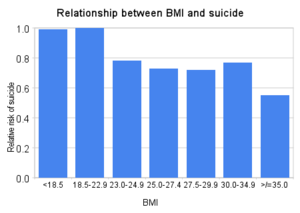Obesity-associated morbidity/ja: Difference between revisions
Created page with "===COVID-19=== イングランドで行われた研究によると、BMIが23を超えると、入院や死亡に至る重度のCOVID-19が直線的に増加し、集中治療室への入院はBMIの全領域にわたって直線的に増加した。BMIが高いことによるCOVID-19リスクの差は、40歳未満または黒人で最も顕著であった。メキシコの研究では、肥満だけでCOVID-19による死亡リスクが2.7倍上昇し、糖尿病、免..." Tags: Mobile edit Mobile web edit |
No edit summary Tags: Mobile edit Mobile web edit |
||
| (9 intermediate revisions by the same user not shown) | |||
| Line 103: | Line 103: | ||
妊娠中に肥満になると、以下のような多くの[[congenital malformation/ja|先天奇形]]を持つ子供が生まれるリスクが高くなる: [[anencephaly/ja|無脳症]]や[[spina bifida/ja|二分脊椎]]などの[[neural tube defects/ja|神経管欠損]]、中隔異常を含む心血管異常、[[cleft lip and palate/ja|口唇口蓋裂]]、[[anorectal malformation/ja|肛門奇形]]、四肢短縮異常、[[hydrocephaly/ja|水頭症]]などである。 | 妊娠中に肥満になると、以下のような多くの[[congenital malformation/ja|先天奇形]]を持つ子供が生まれるリスクが高くなる: [[anencephaly/ja|無脳症]]や[[spina bifida/ja|二分脊椎]]などの[[neural tube defects/ja|神経管欠損]]、中隔異常を含む心血管異常、[[cleft lip and palate/ja|口唇口蓋裂]]、[[anorectal malformation/ja|肛門奇形]]、四肢短縮異常、[[hydrocephaly/ja|水頭症]]などである。 | ||
==子宮内胎児死亡=== | ===子宮内胎児死亡=== | ||
母親の肥満は子宮内胎児死亡のリスク増加と関連している。 | 母親の肥満は子宮内胎児死亡のリスク増加と関連している。 | ||
| Line 196: | Line 196: | ||
イングランドで行われた研究によると、BMIが23を超えると、入院や死亡に至る重度のCOVID-19が直線的に増加し、集中治療室への入院はBMIの全領域にわたって直線的に増加した。BMIが高いことによるCOVID-19リスクの差は、40歳未満または黒人で最も顕著であった。メキシコの研究では、肥満だけでCOVID-19による死亡リスクが2.7倍上昇し、糖尿病、免疫抑制、高血圧などの合併症があるとさらにリスクが上昇することがわかった。米国の研究では、COVID患者の年齢とBMIには逆相関があり、年齢が若いほどBMIが高いことがわかった。 | イングランドで行われた研究によると、BMIが23を超えると、入院や死亡に至る重度のCOVID-19が直線的に増加し、集中治療室への入院はBMIの全領域にわたって直線的に増加した。BMIが高いことによるCOVID-19リスクの差は、40歳未満または黒人で最も顕著であった。メキシコの研究では、肥満だけでCOVID-19による死亡リスクが2.7倍上昇し、糖尿病、免疫抑制、高血圧などの合併症があるとさらにリスクが上昇することがわかった。米国の研究では、COVID患者の年齢とBMIには逆相関があり、年齢が若いほどBMIが高いことがわかった。 | ||
==リウマチおよび整形外科的リスク== | |||
{{Anchor|Rheumatological and orthopedic risks}} | |||
{{See also|Rheumatology | {{See also/ja|Rheumatology/ja}} | ||
[[File:Gout2010.JPG|thumb| | [[File:Gout2010.JPG|thumb|痛風]] | ||
===痛風=== | |||
BMI21~22.9の男性に比べ、BMI30~34.9の男性は2.33倍、BMI35以上の男性は2.97倍[[痛風]]が多い。減量はこれらのリスクを減少させる。 | |||
===運動能力の低下=== | |||
=== | 肥満と筋骨格系の痛みや障害には強い関連がある。 | ||
===変形性関節症=== | |||
[[osteoarthritis/ja|関節炎]]の発生率は、体重のかかる関節とかからない関節の両方で増加する。減量と運動は変形性関節症のリスクを軽減する。 | |||
===腰痛=== | |||
=== | 肥満の人は、「標準」体重の人の2倍から4倍腰痛になりやすい。 | ||
==外傷== | |||
{{Anchor|Traumatic injury}} | |||
女性では、低BMIは一般に骨粗鬆症性骨折の危険因子である。一方、肥満はほとんどの骨粗鬆症性骨折の予防因子である。 | |||
==泌尿器系および腎臓系のリスク== | |||
{{Anchor|Urological and nephrological risks}} | |||
{{See also|Urology|Nephrology}}[[File:Urinary system 00000.gif|upright=0.5|thumb|left| | {{See also/ja|Urology|Nephrology/ja}}[[File:Urinary system 00000.gif|upright=0.5|thumb|left|泌尿器系]] | ||
===尿失禁=== | |||
== | [[Urge incontinence/ja|切迫性]]、[[stress incontinence/ja|ストレス性]]、および混合性尿失禁はすべて、肥満者では発生率が高い。尿失禁の割合は、「正常」体重の人の約2倍である。尿失禁は減量によって改善する。 | ||
[[Urge incontinence| | |||
===慢性腎臓病=== | |||
肥満は[[chronic kidney disease/ja|慢性腎臓病]]のリスクを3~4倍高める。 | |||
===性腺機能低下症=== | |||
男性では、肥満と[[metabolic syndrome/ja|メタボリックシンドローム]]の両方が[[estrogen/ja|エストロゲン]]と[[adipokine/ja|アディポカイン]]の産生を増加させる。これは[[gonadotropin-releasing hormone/ja|ゴナドトロピン放出ホルモン]]を減少させ、ひいては[[luteinizing hormone/ja|黄体形成ホルモン]]と[[follicle stimulating hormone/ja|卵胞刺激ホルモン]]の両方を減少させる。その結果、[[testis/ja|精巣]]の[[testosterone/ja|テストステロン]]産生が減少し、アディポカインレベルがさらに上昇する。これがさらに体重増加を引き起こす。 | |||
===勃起不全=== | |||
肥満の男性は[[erectile dysfunction/ja|勃起不全]]を経験することがあり、減量することで性機能を改善することができる。 | |||
==こちらも参照== | ==こちらも参照== | ||
Latest revision as of 13:06, 4 March 2024
| Obesity-associated morbidity/ja | |
|---|---|
 | |
| 肥満は、人々の生活の質に悪影響を及ぼす多くの医学的合併症を引き起こす可能性がある。 | |
| Specialty | 内分泌学(その他の専門分野) |
| aシリーズの一部である。 |
| 体重 |
|---|

肥満ではないが過体重であることの健康への影響については議論があり、過体重(BMI25.0~29.9)に分類される人の死亡率は、理想体重(BMI18.5~24.9)の人よりも実際に低い可能性を示す研究もある。過体重の人の健康リスクは、医療の改善の結果、時間の経過とともに減少している可能性がある。肥満に関連した病状の中には、肥満による直接的な影響ではなく、肥満者に対する医療上の差別によるストレスの結果であるものもあり、肥満者が受ける医療が比較的貧弱であるために悪化しているものもある。
医療差別
肥満には社会的スティグマがあるため、肥満の人は正常なBMI 体重の範囲内の人よりも貧しい医療を受ける可能性があり、肥満と悪い健康転帰の関係を助長している可能性がある。実際の体重の状態に関係なく、体重に関連した差別を経験する人は、体重に関連した差別を経験しない人に比べて、同様に健康上の転帰が不良である。また、肥満の人は、たとえ医学的な問題によって体重が増えたとしても、肥満でない人に比べて医療を求める傾向が低い。コロンビア大学健康政策・管理学部のピーター・ミューニッヒ教授は、肥満に関連した病状は「脂肪率だけからではなく、肥満であることに関連した社会的スティグマによって引き起こされる心理的ストレスからも引き起こされる」可能性があると提唱している。
心臓学的リスク

体重は、現在(2014年現在)のリスク評価ツールでは、心血管疾患の独立した予測危険因子とはみなされていない。肥満が増加しているにもかかわらず、心血管疾患による死亡率は減少しており、少なくとも1つの臨床試験は、試験中の減量介入によって心血管疾患が減少しなかったため、早期に中止された。
虚血性心疾患
腹部肥満は狭心症や心筋梗塞などの心血管系疾患と関連している。しかし、全体的な肥満(BMIで測定)は心筋梗塞の誤診につながる可能性があり、急性心筋梗塞後の死亡率を低下させる可能性がある。
2008年、ヨーロッパのガイドラインは、ヨーロッパの成人の虚血性心疾患の35%は肥満が原因であると結論づけた。
鬱血性心不全
肥満があると、男性では心不全の約11%、女性では約14%が発症する。
高血圧
高血圧患者の85%以上はBMIが25以上であるが、おそらく食事は体重よりも重要な因子である。肥満と高血圧の関連は、動物実験および臨床研究において見出されており、肥満誘発性高血圧には複数の潜在的メカニズムがあることが示唆されている。これらのメカニズムには、交感神経系の活性化やレニン-アンジオテンシン系の活性化が含まれる。2007年の時点では、小児の高血圧と肥満の間に関連があるかどうかは不明であったが、小児の過体重が増加しているにもかかわらず血圧が上昇しているという直接的な証拠はほとんどない。
コレステロール値の異常
肥満は血液中のLDLコレステロールレベルの上昇とHDLコレステロールレベルの低下と関連している。
深部静脈血栓症と肺塞栓症
肥満は静脈血栓塞栓症のリスクを約2.3倍高める。
皮膚科学的リスク
肥満は妊娠線、黒色表皮腫、リンパ浮腫、蜂巣炎、多毛症、間擦疹の発生率と関連している。
内分泌リスク

糖尿病
肥満と2型糖尿病の関連性は非常に強く、1970年代に研究者たちはこれを「糖尿病」と呼び始めた。男性では糖尿病患者の64%、女性では77%が体重過多である。
女性化乳房
一部の患者では、肥満は末梢でのアンドロゲンからエストロゲンへの変換の上昇と関連している可能性がある。
胃腸リスク
胃食道逆流症
いくつかの研究で、GERDの症状の頻度と重症度はBMIとともに増加し、低体重の人はGERD症状が最も少なく、高度肥満の人はGERD症状が最も多いことが示されている。しかし、ほとんどの研究では非外科的減量によってGERD症状が改善することはないとされている。
胆石症(胆石症)
肥満により胆汁中のコレステロール量が増加し、結石が形成される。
生殖系(または生殖器系)
多嚢胞性卵巣症候群(PCOS)
インスリン抵抗性との関連から、多嚢胞性卵巣症候群(PCOS)では肥満のリスクが高まる。米国ではPCOS患者の約60%がBMI30以上である。PCOSが肥満を助長しているのか、あるいはその逆なのかはまだ不明である。
不妊
肥満は男女ともに不妊の原因となる。 これは主に、過剰なエストロゲンが女性では正常な排卵を妨げ、男性では精子形成を変化させることによる。原発性不妊症の6%を引き起こすと考えられている。2013年のレビューによると、肥満は男性の乏精子症と無精子症のリスクを増加させ、そのオッズ比は1.3であった。1.3. 病的な肥満であれば、オッズ比は2.0に増加する。
妊娠の合併症
肥満は妊娠中の多くの合併症と関連している: 出血、感染症、母体の入院日数の増加、乳児のNICU必要日数の増加などである。肥満の女性は、早産や低出生体重児のリスクも増加させる。
肥満の女性の帝王切開の割合は、「標準」体重の女性に比べ2倍以上である。これは肥満の社会的烙印が一因であるとの指摘もある。
先天異常
妊娠中に肥満になると、以下のような多くの先天奇形を持つ子供が生まれるリスクが高くなる: 無脳症や二分脊椎などの神経管欠損、中隔異常を含む心血管異常、口唇口蓋裂、肛門奇形、四肢短縮異常、水頭症などである。
子宮内胎児死亡
母親の肥満は子宮内胎児死亡のリスク増加と関連している。
埋もれたペニス
病的肥満における過剰な体脂肪は、場合によっては陰茎を完全に見えなくしたり、「埋没」させたりすることがある。
Neurological risks

脳卒中
虚血性脳卒中は、肥満の男女ともに増加する。
感覚異常
感覚異常は、大腿の神経障害性疼痛またはしびれであり、時に肥満に関連する。
片頭痛
片頭痛(および頭痛一般)は肥満と併存している。片頭痛のリスクは、BMI 30 kg/m2で50%、BMI 35 kg/m2で100%上昇する。因果関係はまだ不明である。
手根管症候群
手根管症候群のリスクは、肥満度が1 kg/m2増加するごとに7.4%上昇すると推定されている。
認知症
あるレビューによると、肥満の人は「普通」の体重の人に比べて認知症の割合が有意に高いということはない。
特発性頭蓋内圧亢進症
特発性頭蓋内圧亢進症、または原因不明の頭蓋内圧亢進症は、視覚障害、頻繁な激しい頭痛、および耳鳴りを引き起こすことがあるまれな疾患である。特発性頭蓋内圧亢進症は肥満の女性に最もよくみられ、肥満者の増加とともにその発症率も増加している。
多発性硬化症
18歳時点で肥満の女性は、BMIが18.5~20.9の女性と比較して、多発性硬化症のリスクが2倍以上増加する。18歳時点で低体重の女性は、多発性硬化症のリスクが最も低い。しかし、成人時の体重は多発性硬化症のリスクとは関連していない。
がん

多くのがんは、太り過ぎや肥満の人に発生頻度が高くなる。イギリスの研究によると、がんの約5%は体重過多が原因である。これらのがんには以下のようなものがある:
肥満度(BMI)が高いと、英国では子宮体がんの41%、胆嚢がん、腎臓がん、肝臓がん、大腸がんの少なくとも10%を含む10種類の一般的ながんの発症リスクが高くなる。癌の手術を受ける人にとっても、肥満は「標準」体重の人に比べて術後の主要合併症のリスク上昇と関連している。
精神医学的リスク

うつ病
肥満はうつ病と関連しているが、これは肥満の物理的影響よりもむしろ社会的要因によるものであろう。しかし、肥満がうつ病によって引き起こされる可能性もある(身体活動の低下や、人によっては食欲の増加による)。また、肥満に関連した障害がうつ病を引き起こす人もいる。減量に何度も失敗することもうつ病につながる可能性がある。
肥満とうつ病の関連は、より重度の肥満者、若年者、女性で最も強い。 しかし、自殺率はBMIの上昇とともに減少する。
社会的スティグマ化
肥満の人は他人から否定的な反応を引き寄せ、社会的スティグマ化のために、人々はどんな状況でも肥満の人を助けようとしない。肥満の人はまた、教育やキャリアの機会が少なく、平均して収入が少なく、一般的に「正常な」体重の人よりも貧しい医療や治療を受ける。
呼吸器系
閉塞性睡眠時無呼吸症候群
肥満は閉塞性睡眠時無呼吸症候群の危険因子である。
肥満性低換気症候群

肥満低換気症候群は、肥満、睡眠中の低酸素、日中の酸化炭素の組み合わせとして定義され、低換気に起因する。
慢性肺疾患
肥満は、喘息やCOPDを含む多くの慢性肺疾患と関連している。
全身麻酔中の合併症
肥満は機能的肺容積を著しく減少させ硬化させるため、全身麻酔下での呼吸管理に特別な戦略が必要となる。
肥満と喘息
肥満による低悪性度の全身性炎症は、喘息の肺機能を悪化させ、喘息増悪のリスクを高めることが示されている。
COVID-19
イングランドで行われた研究によると、BMIが23を超えると、入院や死亡に至る重度のCOVID-19が直線的に増加し、集中治療室への入院はBMIの全領域にわたって直線的に増加した。BMIが高いことによるCOVID-19リスクの差は、40歳未満または黒人で最も顕著であった。メキシコの研究では、肥満だけでCOVID-19による死亡リスクが2.7倍上昇し、糖尿病、免疫抑制、高血圧などの合併症があるとさらにリスクが上昇することがわかった。米国の研究では、COVID患者の年齢とBMIには逆相関があり、年齢が若いほどBMIが高いことがわかった。
リウマチおよび整形外科的リスク

痛風
BMI21~22.9の男性に比べ、BMI30~34.9の男性は2.33倍、BMI35以上の男性は2.97倍痛風が多い。減量はこれらのリスクを減少させる。
運動能力の低下
肥満と筋骨格系の痛みや障害には強い関連がある。
変形性関節症
関節炎の発生率は、体重のかかる関節とかからない関節の両方で増加する。減量と運動は変形性関節症のリスクを軽減する。
腰痛
肥満の人は、「標準」体重の人の2倍から4倍腰痛になりやすい。
外傷
女性では、低BMIは一般に骨粗鬆症性骨折の危険因子である。一方、肥満はほとんどの骨粗鬆症性骨折の予防因子である。
泌尿器系および腎臓系のリスク

尿失禁
切迫性、ストレス性、および混合性尿失禁はすべて、肥満者では発生率が高い。尿失禁の割合は、「正常」体重の人の約2倍である。尿失禁は減量によって改善する。
慢性腎臓病
肥満は慢性腎臓病のリスクを3~4倍高める。
性腺機能低下症
男性では、肥満とメタボリックシンドロームの両方がエストロゲンとアディポカインの産生を増加させる。これはゴナドトロピン放出ホルモンを減少させ、ひいては黄体形成ホルモンと卵胞刺激ホルモンの両方を減少させる。その結果、精巣のテストステロン産生が減少し、アディポカインレベルがさらに上昇する。これがさらに体重増加を引き起こす。
勃起不全
肥満の男性は勃起不全を経験することがあり、減量することで性機能を改善することができる。
こちらも参照
さらに読む
- King, Lauren K.; March, Lyn; Anandacoomarasamy, Ananthila (2013-08-01). "Obesity & osteoarthritis". The Indian Journal of Medical Research. 138 (2): 185–193. ISSN 0971-5916. PMC 3788203. PMID 24056594.Review
- Zhao, Lan-Juan; Jiang, Hui; Papasian, Christopher J; Maulik, Dev; Drees, Betty; Hamilton, James; Deng, Hong-Wen (2008-01-01). "Correlation of Obesity and Osteoporosis: Effect of Fat Mass on the Determination of Osteoporosis". Journal of Bone and Mineral Research. 23 (1): 17–29. doi:10.1359/jbmr.070813. ISSN 1523-4681. PMC 2663586. PMID 17784844.
- Guh, Daphne P; Zhang, Wei; Bansback, Nick; Amarsi, Zubin; Birmingham, C Laird; Anis, Aslam H (25 March 2009). "The incidence of co-morbidities related to obesity and overweight: A systematic review and meta-analysis". BMC Public Health. 9 (1): 88. doi:10.1186/1471-2458-9-88. ISSN 1471-2458. PMC 2667420. PMID 19320986.